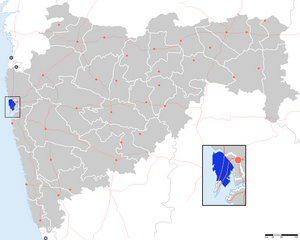Mumbai Suburban
| Mumbai Suburban District | |
|---|---|

|
|
| State | Maharashtra |
| Division : | Konkan |
| Administrative headquarters : | Bandra |
| Area : | 446 km² |
| Residents : | 9,356,962 |
| Population density : | 20,980 inhabitants / km² |
| Website : | mumbaisuburban.gov.in |
The Mumbai Suburban District ( Marathi : मुंबई उपनगर जिल्हा Mumbaī Upanagara Jilhā ) is one of 35 districts of the Maharashtra state in India .
The main town of the district is Bandra (East). The last census in 2011 showed a total population of 9,356,962 people.
history
From pre-Christian times to the year 1343 the area - like the whole region - was ruled by various Buddhist and Hindu rulers. The first state known by name was the Maurya Empire , the last non-Muslim dynasty were the Yadavas of Devagiri. After decades of military clashes with Muslim rulers in northern India, it was occupied by Muslim armies in 1343. Thereafter, various Muslim dynasties ruled until 1534 (Sultanate of Delhi, Bahmani, Dekkan sultanates). From 1500 onwards, there was fierce fighting for rule on the coast between the Muslim rulers and the Portuguese. In 1534 the Muslim Sultanate of Gujarat ceded the area to the Portuguese. The Portuguese held the island of Salsette , on which Mumbai Suburban is located, until 1739. After that, it belonged to the Marathas Empire until 1774 , when it was conquered by troops of the British East India Company . The Marathas finally recognized British rule over Salsette in the Treaty of Salbai in 1782. The British East India Company took over and incorporated the area into the British administrative region of the Bombay Presidency . It first belonged to the Thana District and later came to the Bombay District (now Mumbai City). With India's independence in 1947 and the reorganization of the country, it became part of the new state of Bombay in 1950 . In 1960, Bombay was divided and the area came to the newly created state of Maharashtra. The district was established in its current form on October 1, 1990 from parts of what was then the Mumbai district.
population
The urban population makes up 100 percent of the total population. Because the entire district consists of urbanized suburbs of the city of Mumbai. Mumbai Suburban has a high level of literacy. At the last census in 2011 it totaled 89.91 percent. For men, it is slightly higher at 92.92 percent than for women (86.37 percent). The high surplus of men is striking. For every 1000 men there are only 860 women. But a change is taking place in this relationship. In 2001 there were only 822 women for every 1000 men - while today there are 913 girls for every 1000 boys among 0-6 year olds.
Population development
As everywhere in India, the population in the Mumbai Suburban district has been growing rapidly for decades. In contrast to Mumbai City also between 2001 and 2011. The increase between the last two censuses was 8.29 percent or more than 700,000 people.
A) Mumbai area (now Mumbai City and Mumbai Suburban)

B) Area of today's Mumbai Suburban district

Population of the district by confession
A clear vast majority of the population are Hindus. But there are numerically significant minorities of Muslims, Buddhists, Christians and Jainas. The following table shows the exact religious composition of the population:
| year | Buddhists | Christians | Hindus | Jainas | Muslims | Sikhs | Others 1 | not specified | Total | |||||||||
|---|---|---|---|---|---|---|---|---|---|---|---|---|---|---|---|---|---|---|
| number | % | number | % | number | % | number | % | number | % | number | % | number | % | number | % | Residents | % | |
| 2001 | 464.354 | 5.37% | 340.166 | 3.94% | 5,953,475 | 68.90% | 319,339 | 3.70% | 1,488,987 | 17.23% | 53,271 | 0.62% | 17,833 | 0.21% | 2,994 | 0.03% | 8,640,419 | 100.00% |
|
1 including 11,348 Parsis and 688 Jews (Bani Israel)
Source: 2001 India Census |
||||||||||||||||||
District population by language
Mumbai Suburban is a multi-ethnic area. Less than 40 percent of the population speaks Marathi. There are a number of larger linguistic minorities. Languages with more than 100,000 members are Hindi (with Hindi dialects 1,929,000 people), Urdu, Gujarati, Tamil, Konkani, Kannada, Telugu (144,908), Malayalam (132,008), Bhojpuri (a Hindi dialect; 121,612) and Marwari (a Hindi dialect; 114,409). Sindhi (92,090), Punjabi (90,800), Kachchhi (a Sindhi dialect; 78,910), Bengali (70,337), Tulu (54,531), English (49,752), Oriya (35,062), Rajasthani (26,035) and Nepali (21,239) spoken by over 20,000 people as their mother tongue. The following table shows the exact linguistic composition of the population:
| year | Marathi | Hindi | Urdu | Gujarati | Tamil | Konkani | Kannada | Other | Total | |||||||||
|---|---|---|---|---|---|---|---|---|---|---|---|---|---|---|---|---|---|---|
| number | % | number | % | number | % | number | % | number | % | number | % | number | % | number | % | Residents | % | |
| 2001 | 3,202,847 | 37.07% | 1,631,082 | 18.88% | 1,075,046 | 12.44% | 1,037,872 | 12.01% | 217,641 | 2.52% | 172.416 | 2.00% | 163,639 | 1.89% | 1,139,876 | 13.19% | 8,640,419 | 100.00% |
| Source: 2001 India Census | ||||||||||||||||||
Web links
- District website
- [1] - Map of the Mumbai Suburban District
- [2] - Some background information about the district
- [3] - Economy, nature and sights